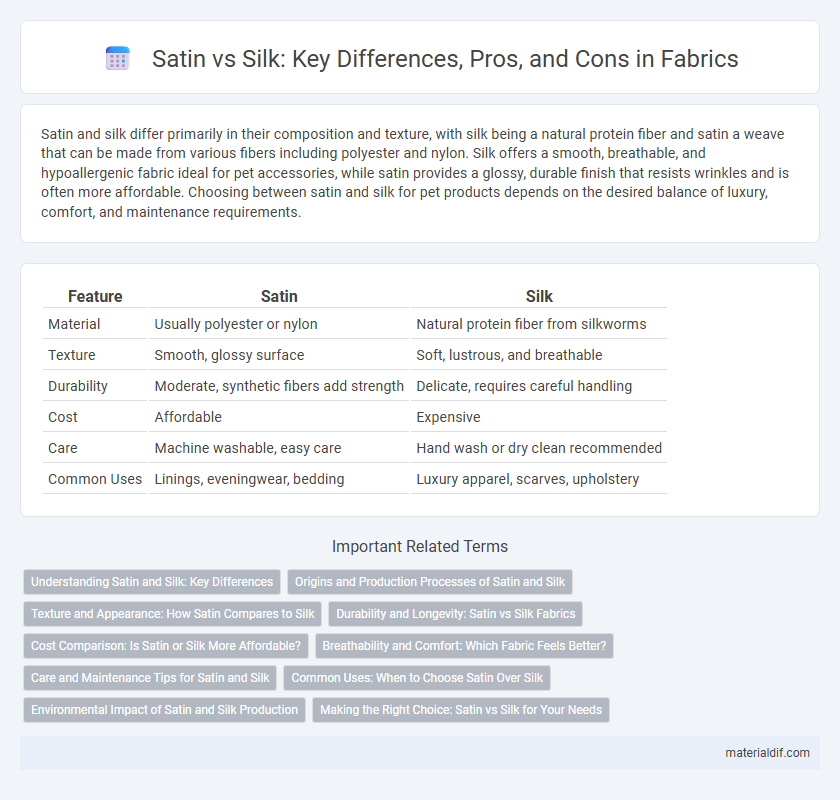Satin and silk differ primarily in their composition and texture, with silk being a natural protein fiber and satin a weave that can be made from various fibers including polyester and nylon. Silk offers a smooth, breathable, and hypoallergenic fabric ideal for pet accessories, while satin provides a glossy, durable finish that resists wrinkles and is often more affordable. Choosing between satin and silk for pet products depends on the desired balance of luxury, comfort, and maintenance requirements.
Table of Comparison
| Feature | Satin | Silk |
|---|---|---|
| Material | Usually polyester or nylon | Natural protein fiber from silkworms |
| Texture | Smooth, glossy surface | Soft, lustrous, and breathable |
| Durability | Moderate, synthetic fibers add strength | Delicate, requires careful handling |
| Cost | Affordable | Expensive |
| Care | Machine washable, easy care | Hand wash or dry clean recommended |
| Common Uses | Linings, eveningwear, bedding | Luxury apparel, scarves, upholstery |
Understanding Satin and Silk: Key Differences
Satin is a weaving technique that creates a glossy surface by floating threads, commonly made from polyester or nylon, while silk is a natural fiber harvested from silkworm cocoons known for its softness and breathability. Silk offers superior moisture-wicking properties and hypoallergenic qualities, making it ideal for sensitive skin, whereas satin's synthetic variants tend to be more affordable and durable but less breathable. Understanding these differences helps in selecting the right fabric for specific uses such as luxury clothing, bedding, or upholstery, balancing comfort, appearance, and maintenance.
Origins and Production Processes of Satin and Silk
Silk is a natural fiber produced by silkworms through the process of spinning cocoons, predominantly cultivated in China and India for thousands of years. Satin is not a fiber but a weaving technique that creates a smooth, glossy surface by floating warp or weft yarns, commonly made from synthetic fibers like polyester or natural fibers such as silk. The production of silk involves sericulture and careful harvesting of cocoons, whereas satin's creation depends on weaving methods applied to various fibers to achieve its characteristic sheen.
Texture and Appearance: How Satin Compares to Silk
Satin features a smooth, glossy surface with a lustrous sheen that resembles silk but is typically more reflective due to its weave structure. Silk offers a naturally soft, luxurious texture with subtle variations and a gentle, matte glow that enhances its rich appearance. While satin's shine tends to be uniform and synthetic in feel, silk provides a breathable, lightweight drape prized for its natural elegance and tactile warmth.
Durability and Longevity: Satin vs Silk Fabrics
Satin, often made from synthetic fibers like polyester, offers greater durability and resistance to wear compared to natural silk, which is more delicate and prone to fraying. Silk fibers, derived from silkworm cocoons, provide a luxurious feel but require careful handling to maintain their longevity. Choosing satin for upholstery or everyday wear ensures extended fabric life, whereas silk is better suited for special occasions with gentle use.
Cost Comparison: Is Satin or Silk More Affordable?
Satin, typically made from synthetic fibers such as polyester or nylon, is generally more affordable than natural silk, which is produced by silkworms and involves a labor-intensive harvesting process. While silk boasts superior breathability and a luxurious texture, satin offers a budget-friendly alternative with similar glossy appearance. Consumers seeking cost-effective elegance often choose satin for its affordability without sacrificing aesthetic appeal.
Breathability and Comfort: Which Fabric Feels Better?
Satin, typically made from polyester or nylon, offers a smooth, glossy surface but lacks breathability compared to silk, which is a natural protein fiber known for its excellent moisture-wicking properties and temperature regulation. Silk's natural fibers allow better air circulation, enhancing comfort and preventing overheating during wear. For those prioritizing breathability and all-day comfort, silk generally feels superior due to its softness and ability to maintain a cool, dry feel against the skin.
Care and Maintenance Tips for Satin and Silk
Satin fabric requires gentle washing with cold water and mild detergent to avoid damage, and it is best air-dried away from direct sunlight to maintain its smooth texture and sheen. Silk demands even more delicate care, including hand washing or dry cleaning, use of specialized silk detergent, and avoiding wringing to preserve its natural fibers and luster. Both fabrics benefit from low-heat ironing on the reverse side or steaming to prevent damage, ensuring longevity and a pristine appearance.
Common Uses: When to Choose Satin Over Silk
Satin is commonly chosen over silk for upholstery, evening wear, and costume design due to its durability and glossy finish, which provides a luxurious appearance at a lower cost. Satin's smooth texture and resistance to wrinkles make it ideal for formal garments like prom dresses and bridal gowns that require both elegance and practicality. In contrast, silk is preferred for high-end fashion and delicate items where natural fibers and breathability are paramount.
Environmental Impact of Satin and Silk Production
Silk production involves sericulture, requiring mulberry trees and silk worms, resulting in a natural yet resource-intensive process with higher water and land use. Satin, commonly made from synthetic fibers like polyester or nylon, relies on petroleum-based materials that contribute to pollution and non-biodegradability. Choosing silk supports a biodegradable fabric with a renewable resource, while satin's synthetic variants pose greater environmental challenges due to chemical production and microplastic release.
Making the Right Choice: Satin vs Silk for Your Needs
Choosing between satin and silk depends on your priorities such as budget, texture, and maintenance. Silk, a natural fiber derived from silkworm cocoons, offers breathability, hypoallergenic properties, and a luxurious, smooth feel, making it ideal for sensitive skin and high-end garments. Satin, a weave that can be made from various fibers including polyester or nylon, provides a glossy surface and durability at a lower cost, making it suitable for everyday wear and decorative applications where affordability and easy care are essential.
Satin vs Silk Infographic

 materialdif.com
materialdif.com